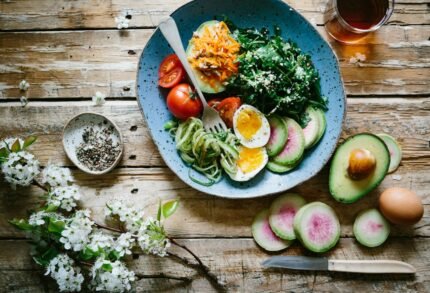Medically reviewed by Dr. Ramesh Gaddam, M.D. — Written by Sumalatha, D.N.H.E
Table of Contents
ToggleA good weight loss diet plan is key to reaching your goals effectively. It helps you stay on track and makes the process easier. This guide will show you how to set achievable goals and follow a balanced diet and exercise routine.
With the right plan, you’ll find it simpler to lose weight and stay motivated. Let’s explore how a clear and structured approach can help you succeed in your weight loss journey.
1. Understanding Weight Loss
To lose weight, you need to consume fewer calories than your body uses. This means eating less than you burn each day.
Choose foods that are rich in vitamins, minerals, and other nutrients but lower in calories. These foods help you stay healthy while losing weight.
Aim for steady and gradual weight loss rather than quick results. Setting small, manageable goals can help you stay on track.
Your attitude and drive are crucial. A positive mindset and strong motivation will help you stick with your weight loss plan.
2. Setting Weight Loss Goals
Short-Term vs. Long-Term Goals
Short-term goals are smaller, immediate targets, like losing 2 pounds in a week. Long-term goals are bigger, such as losing 20 pounds over several months. Both are important for overall success.
SMART Criteria: Make your goals SMART:
- Specific: Clearly define what you want to achieve (e.g., “I want to lose 5 pounds in a month”).
- Measurable: Track your progress with numbers (e.g., “I will track my weight weekly”).
- Achievable: Set realistic goals based on your lifestyle (e.g., “I can realistically lose 1-2 pounds per week”).
- Relevant: Ensure your goals fit your overall weight loss plan (e.g., “Losing weight will help me improve my health”).
- Time-bound: Set a deadline for achieving your goal (e.g., “I will reach my goal by the end of the month”).
Importance of Tracking Progress
Write down what you eat each day. This helps you see where you might need to make changes and keeps you accountable.
Regularly check your weight and how your clothes fit. This helps you see how your efforts are paying off and can motivate you to keep going.
3. Choosing the Right Diet Plan
Look at what has worked or not worked for you before. Reflect on your current eating habits to understand what might need to change.
Choose a diet that includes foods you enjoy and can stick with. This will make it easier to follow the plan and stay motivated.
Types of Diets
Low-Carb, Mediterranean, Plant-Based, etc.: Different diets focus on various food groups and nutrients. For example:
Low-Carb Diets reduce carbohydrate intake.
Mediterranean Diets emphasize fruits, vegetables, and healthy fats.
Plant-Based Diets focus on foods from plants and exclude or limit animal products.
Pick a diet that you can maintain long-term and that meets your health needs. A sustainable diet is one that fits your lifestyle and supports overall well-being.
Dietitians can help create a diet plan tailored to your specific needs, preferences, and health goals. They provide expert advice and support to help you succeed.
4. Nutritional Guidelines for Weight Loss
1. Macronutrients and Their Roles
Proteins, Carbohydrates, and Fats: Each macronutrient has a different role in your diet:
- Proteins help build and repair tissues and can keep you feeling full.
- Carbohydrates provide energy, but choosing whole grains and vegetables is better than refined sugars.
- Fats are essential for absorbing vitamins and providing energy, but focus on healthy fats like those from nuts, seeds, and avocados.
Recommended Ratios for Weight Loss: A balanced approach often includes about 30% protein, 45-55% carbohydrates, and 20-30% fats. Adjust these ratios based on your personal needs and preferences.
2. Portion Control and Mindful Eating
Use smaller plates, measure your food, or check serving sizes on food labels to avoid overeating.
Eat when you’re hungry and stop when you’re full. Pay attention to your body’s signals to avoid eating out of habit or boredom.
3. Hydration
Drinking enough water helps control hunger, boosts metabolism, and supports overall health.
Aim to drink at least 8 glasses of water a day. Adjust based on your activity level and climate, and consider drinking water before meals to help control portion sizes.
5. Sample Meal Plans
1200-Calorie Diet Chart
Breakfast:
- Greek yogurt with berries and a drizzle of honey
- A small handful of almonds
Lunch:
- Grilled chicken salad with mixed greens, cherry tomatoes, cucumbers, and a light vinaigrette
- A piece of whole-grain bread
Snack:
- A medium apple
- A small serving of low-fat cottage cheese
Dinner:
- Baked salmon with a side of steamed broccoli and quinoa
- A mixed green salad with lemon juice as dressing
Snack:
- Carrot sticks with a tablespoon of hummus
7-Day Weight Loss Meal Plan
Day 1:
- Breakfast: Smoothie with spinach, banana, and almond milk
- Lunch: Turkey wrap with lettuce, tomato, and a whole-grain tortilla
- Snack: Handful of mixed nuts
- Dinner: Stir-fried tofu with vegetables and brown rice
Day 2:
- Breakfast: Oatmeal with fresh berries and a sprinkle of chia seeds
- Lunch: Lentil soup with a side salad
- Snack: Sliced cucumber with a light yogurt dip
- Dinner: Grilled chicken breast with roasted sweet potatoes and green beans
Day 3:
- Breakfast: Scrambled eggs with spinach and mushrooms
- Lunch: Quinoa salad with chickpeas, bell peppers, and a lemon-tahini dressing
- Snack: A small pear
- Dinner: Baked cod with a side of sautéed kale and a small baked potato
Day 4:
- Breakfast: Chia pudding topped with sliced strawberries
- Lunch: Mixed bean salad with tomatoes, corn, and avocado
- Snack: Greek yogurt with a teaspoon of honey
- Dinner: Turkey meatballs with marinara sauce and spaghetti squash
Day 5:
- Breakfast: Whole-grain toast with avocado and a poached egg
- Lunch: Grilled veggie sandwich on whole-grain bread
- Snack: A handful of cherry tomatoes
- Dinner: Stuffed bell peppers with lean ground beef and a side of mixed greens
Day 6:
- Breakfast: Smoothie bowl with blended berries and a topping of granola
- Lunch: Chicken Caesar salad with a light dressing
- Snack: A small handful of trail mix
- Dinner: Shrimp stir-fry with snow peas and a side of jasmine rice
Day 7:
- Breakfast: Cottage cheese with pineapple chunks
- Lunch: Spinach and feta stuffed chicken breast with a side of roasted carrots
- Snack: A small apple with a tablespoon of almond butter
- Dinner: Veggie-loaded chili with a side of cornbread
6. Physical Activity
Aerobic Exercise:
Activities like walking, running, cycling, and swimming that increase your heart rate and burn calories. Aim for at least 150 minutes of moderate aerobic exercise per week.
Strength Training:
Exercises like weight lifting, resistance bands, and bodyweight exercises that build muscle. Aim to include strength training exercises at least two days a week.
Recommendations for Frequency and Duration:
For a balanced workout routine, aim for 150 minutes of moderate-intensity aerobic exercise or 75 minutes of vigorous-intensity activity each week, spread over several days.
Incorporate strength training exercises for all major muscle groups at least twice a week, with a day of rest between sessions to allow for muscle recovery.
Additionally, include stretching or yoga a few times a week to enhance flexibility and balance.
Finding Enjoyable Activities to Maintain Motivation
Pick exercises that you find fun, whether it’s dancing, hiking, or playing a sport. The more you enjoy the activity, the more likely you are to stick with it.
Vary your workouts to keep them interesting and prevent boredom. Try new classes, sports, or outdoor activities.
Set small fitness goals and track your progress. Celebrate achievements to stay motivated and engaged in your fitness journey.
7. Overcoming Challenges
In weight loss journeys, common challenges include emotional eating, where people eat due to stress or boredom rather than hunger, which can slow progress. Social events like parties can be tough because of tempting foods and pressure to eat more.
Plateaus, where weight loss seems to stop even though you’re following your plan, are also common. To handle setbacks, try healthy stress-relief methods like exercising, practicing mindfulness or meditation, or journaling your feelings.
Celebrate achievements beyond just weight loss, such as getting fitter, sleeping better, or feeling healthier, to stay motivated and keep moving toward your goals.
Conclusion
In conclusion, achieving weight loss success involves understanding and overcoming challenges such as emotional eating, social pressures, and plateaus.
By setting realistic goals, choosing a balanced diet, and incorporating regular exercise, you create a strong foundation for progress.
Managing stress through healthy practices and celebrating non-scale victories can further boost motivation.
Staying committed to your personalized plan and recognizing improvements in your overall health will help you stay on track and achieve lasting results.
Frequently Asked Questions
1. What are the top diets for overall health in 2024?
The top diets for overall health in 2024 include the Mediterranean Diet, the DASH Diet (Dietary Approaches to Stop Hypertension), and the MIND Diet (Mediterranean-DASH Intervention for Neurodegenerative Delay).
The Mediterranean Diet focuses on whole foods and healthy fats, the DASH Diet aims at reducing sodium and promoting heart health, and the MIND Diet combines elements of both to enhance brain health.
2. How does the Mediterranean Diet benefit overall health?
The Mediterranean Diet benefits overall health by emphasizing whole foods like fruits, vegetables, whole grains, nuts, and healthy fats such as olive oil. It is recognized for its cardiovascular benefits and long-term sustainability.
3. What is the purpose of the DASH Diet?
The DASH Diet aims to reduce sodium intake while promoting the consumption of fruits, vegetables, whole grains, and lean proteins. It is effective in managing blood pressure and supporting heart health.
4. What is the MIND Diet and how does it work?
The MIND Diet is a combination of the Mediterranean and DASH diets, designed to improve brain health and reduce cognitive decline. It focuses on nutrient-rich foods that support brain function.
5. Which weight loss plan is considered most effective?
The Weight Watchers (WW) diet is often cited as the most effective weight loss plan due to its structured support system and flexibility in food choices, which helps individuals adhere to their weight loss goals long-term.
6. What is the 5:5 Diet Plan?
The 5:5 Diet Plan involves eating normally for five days of the week and restricting calorie intake for the remaining two days. It is designed to balance regular eating with intermittent fasting.
7. How does the Lose 5kg in 5 Days Diet Plan work?
The Lose 5kg in 5 Days Diet Plan typically involves a very low-calorie intake and may include meal replacements. However, such rapid weight loss is generally not sustainable or recommended for long-term health.
8. What is the 54321 Diet Plan?
The 54321 Diet Plan encourages eating five servings of vegetables, four servings of fruit, three servings of whole grains, two servings of protein, and one serving of healthy fats each day to promote balanced nutrition.
9. Can you explain the 6:5:4:3:2:1 Diet?
The 6:5:4:3:2:1 Diet is a structured plan that specifies portions of different food groups to ensure a balanced intake of nutrients.
10. What is the purpose of the Indian 5:2 Diet?
The Indian 5:2 Diet is a variation of the 5:2 diet adapted to Indian cuisine. It involves normal eating for five days and restricted calorie intake for two days, catering to traditional Indian dietary preferences.
11. How does the 30-Day Diet work?
The 30-Day Diet is a structured program designed to make sustainable dietary changes over the course of a month, promoting long-term health and weight management.
12. What is the Fast 500 Diet?
The Fast 500 Diet is a low-calorie diet that may involve meal replacements or strict calorie counting to achieve rapid weight loss. It focuses on significantly reducing calorie intake to promote quick results.
References
1. Healthy Eating Plan. National Heart, Lung, and Blood Institute. http://www.nhlbi.nih.gov/health/educational/lose_wt/eat/calories.htm. (n.d.). Accessed 07 November 2016.
2. 25 Tips for Weight Loss That Actually Work. Everyday Health. . Updated April 24, 2024.
3. Diet for rapid weight loss. Mount Sinai. https://www.mountsinai.org/health-library/special-topic/diet-for-rapid-weight-loss. Accessed August 9, 2024.
– While rapid weight loss diets can lead to quick results, they are not recommended for long-term success. Slow, steady weight loss through diet changes and exercise is more effective for maintaining weight loss[5].
Also Read:
Medically reviewed by Dr. Ramesh Gaddam, M.D.

General Physician, Diabetologist, and Critical Care Specialist.
Related
Discover more from Health Build-Up
Subscribe to get the latest posts sent to your email.







2 thoughts on “Top 5 Weight Loss Diet Plans to Achieve Goals Easily (2024)”
Comments are closed.